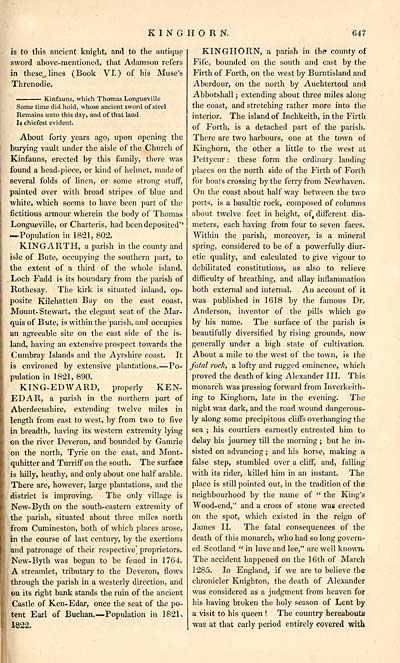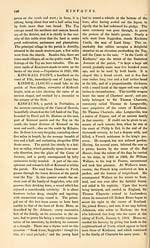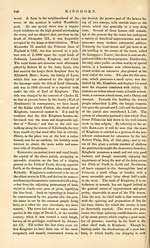Gazetteer of Scotland > Volume 2
(163) Page 647
Download files
Complete book:
Individual page:
Thumbnail gallery: Grid view | List view

K I N G H O R N.
647
is to this ancient knight, and to the antique
sword above-mentioned, that Adamson refers
in these,, lines (Book VI.) of his Muse's
Threnodie.
Kinfauns, which Thomas Longueville
Some time did hold, whose ancient sword of steel
Remains unto this day, and of that land
Is chiefest evident.
About forty years ago, upon opening the
burying vault under the aisle of the Church of
Kinfauns, erected by this family, there was
found a head-piece, or kind of helmet, made of
several folds of linen, or some strong stuff,
painted over with broad stripes of blue and
white, which seems to have been part of the
fictitious armour wherein the body of Thomas
Longueville, or Charteris, had been deposited"
—Population in 1821, 802.
KINGARTH, a parish in the county and
isle of Bute, occupying the southern part, to
the extent of a third of the whole island.
Loch Fadd is its boundary from the parish of
Rothesay. The kirk is situated inland, op-
posite Kilchatten Bay on the east coast.
Mount- Stewart, the elegant seat of the Mar-
quis of Bute, is within the parish, and occupies
an agreeable site on the east side of the is-
land, having an extensive prospect towards the
Cumbray Islands and the Ayrshire coast. It
is environed by extensive plantations. — Po-
pulation in 1821, 890.
KING-EDWARD, properly KEN-
ED A R, a parish in the northern part of
Aberdeenshire, extending twelve miles in
length from east to west, by from two to five
in breadth, having its western extremity lying
on the river Deveron, and bounded by Gamrie
on the north, Tyrie on the east, and Mont-
quhitter and Turriff on the south. The surface
is hilly, heathy, and only about one half arable.
There are, however, large plantations, and the
district is improving. The only village is
New-Byth on the south-eastern extremity of
the parish, situated about three miles north
from Cumineston, both of which places arose,
in the course of last century, by the exertions
and patronage of their respective" proprietors.
New-Byth was begun to be feued in 1764.
A streamlet, tributary to the Deveron, flows
I through the parish in a westerly direction, and
on its right bank stands the nun of the ancient
Castle of Ken-Edar, once the seat of the po-
tent Earl of Buchan.— Population in 1821,
1822.
KINGHORN, a parish in the county of
Fife, bounded on the south and east by the
Firth of Forth, on the west by Burntisland and
Aberdour, on the north by Auchtertoul and
Abbotshall ; extending about three miles along
the coast, and stretching rather more into the
interior. The island of Inchkeith, in the Firth
of Forth, is a detached part of the parish.
There are two harbours, one at the town of
Kinghorn, the other a little to the west at
Pettycur : these form the ordinary landing
places on the north side of the Firth of Forth
for boats crossing by the ferry from Newhaven.
On the coast about half way between the two
ports, is a basaltic rock, composed of columns
about twelve feet in height, of, different dia-
meters, each having from four to seven faces.
Within the parish, moreover, is a mineral
spring, considered to be of a powerfully diur-
etic quality, and calculated to give vigour to
debilitated constitutions, as also to relieve
difficulty of breathing, and allay inflammation
both external and internal. An account of it
was published in 1618 by the famous Dr.
Anderson, inventor of the pills which go
by his name. The surface of the parish is
beautifully diversified by rising grounds, now
generally under a high state of cultivation.
About a mile to the west of the town, is Ihe
fatal rock, a lofty and rugged eminence, which
proved the death of king Alexander III. This
monarch was pressing forward from Inverkeith-
ing to Kinghorn, late in the evening. The
night was dark, and the road wound dangerous-
ly along some precipitous cliffs overhanging the
sea ; his courtiers earnestly entreated him to
delay his journey till the morning ; but he in-
sisted on advancing ; and his horse, making a
false step, stumbled over a cliff, and, falling
with its rider, killed him in an instant. The
place is still pointed out, in the tradition of the
neighbourhood by the name of " the King's
Wood-end," and a cross of stone was erected
on the spot, which existed in the reign of
James II. The fatal consequences of the
death of this monarch, who had so long govern-
ed Scotland " in luve and lee," are well known.
The accident happened on the 16th of March
1285. In England, if we are to believe the
chronicler Knighton, the death of Alexander
was considered as a judgment from heaven for
his having broken the holy season of Lent by
a visit to his queen ! The country hereabouts
was at that early period entirely covered with
647
is to this ancient knight, and to the antique
sword above-mentioned, that Adamson refers
in these,, lines (Book VI.) of his Muse's
Threnodie.
Kinfauns, which Thomas Longueville
Some time did hold, whose ancient sword of steel
Remains unto this day, and of that land
Is chiefest evident.
About forty years ago, upon opening the
burying vault under the aisle of the Church of
Kinfauns, erected by this family, there was
found a head-piece, or kind of helmet, made of
several folds of linen, or some strong stuff,
painted over with broad stripes of blue and
white, which seems to have been part of the
fictitious armour wherein the body of Thomas
Longueville, or Charteris, had been deposited"
—Population in 1821, 802.
KINGARTH, a parish in the county and
isle of Bute, occupying the southern part, to
the extent of a third of the whole island.
Loch Fadd is its boundary from the parish of
Rothesay. The kirk is situated inland, op-
posite Kilchatten Bay on the east coast.
Mount- Stewart, the elegant seat of the Mar-
quis of Bute, is within the parish, and occupies
an agreeable site on the east side of the is-
land, having an extensive prospect towards the
Cumbray Islands and the Ayrshire coast. It
is environed by extensive plantations. — Po-
pulation in 1821, 890.
KING-EDWARD, properly KEN-
ED A R, a parish in the northern part of
Aberdeenshire, extending twelve miles in
length from east to west, by from two to five
in breadth, having its western extremity lying
on the river Deveron, and bounded by Gamrie
on the north, Tyrie on the east, and Mont-
quhitter and Turriff on the south. The surface
is hilly, heathy, and only about one half arable.
There are, however, large plantations, and the
district is improving. The only village is
New-Byth on the south-eastern extremity of
the parish, situated about three miles north
from Cumineston, both of which places arose,
in the course of last century, by the exertions
and patronage of their respective" proprietors.
New-Byth was begun to be feued in 1764.
A streamlet, tributary to the Deveron, flows
I through the parish in a westerly direction, and
on its right bank stands the nun of the ancient
Castle of Ken-Edar, once the seat of the po-
tent Earl of Buchan.— Population in 1821,
1822.
KINGHORN, a parish in the county of
Fife, bounded on the south and east by the
Firth of Forth, on the west by Burntisland and
Aberdour, on the north by Auchtertoul and
Abbotshall ; extending about three miles along
the coast, and stretching rather more into the
interior. The island of Inchkeith, in the Firth
of Forth, is a detached part of the parish.
There are two harbours, one at the town of
Kinghorn, the other a little to the west at
Pettycur : these form the ordinary landing
places on the north side of the Firth of Forth
for boats crossing by the ferry from Newhaven.
On the coast about half way between the two
ports, is a basaltic rock, composed of columns
about twelve feet in height, of, different dia-
meters, each having from four to seven faces.
Within the parish, moreover, is a mineral
spring, considered to be of a powerfully diur-
etic quality, and calculated to give vigour to
debilitated constitutions, as also to relieve
difficulty of breathing, and allay inflammation
both external and internal. An account of it
was published in 1618 by the famous Dr.
Anderson, inventor of the pills which go
by his name. The surface of the parish is
beautifully diversified by rising grounds, now
generally under a high state of cultivation.
About a mile to the west of the town, is Ihe
fatal rock, a lofty and rugged eminence, which
proved the death of king Alexander III. This
monarch was pressing forward from Inverkeith-
ing to Kinghorn, late in the evening. The
night was dark, and the road wound dangerous-
ly along some precipitous cliffs overhanging the
sea ; his courtiers earnestly entreated him to
delay his journey till the morning ; but he in-
sisted on advancing ; and his horse, making a
false step, stumbled over a cliff, and, falling
with its rider, killed him in an instant. The
place is still pointed out, in the tradition of the
neighbourhood by the name of " the King's
Wood-end," and a cross of stone was erected
on the spot, which existed in the reign of
James II. The fatal consequences of the
death of this monarch, who had so long govern-
ed Scotland " in luve and lee," are well known.
The accident happened on the 16th of March
1285. In England, if we are to believe the
chronicler Knighton, the death of Alexander
was considered as a judgment from heaven for
his having broken the holy season of Lent by
a visit to his queen ! The country hereabouts
was at that early period entirely covered with
Set display mode to: Large image | Transcription
Images and transcriptions on this page, including medium image downloads, may be used under the Creative Commons Attribution 4.0 International Licence unless otherwise stated. ![]()
| Gazetteers of Scotland, 1803-1901 > Gazetteer of Scotland > Volume 2 > (163) Page 647 |
|---|
| Permanent URL | https://digital.nls.uk/97432778 |
|---|
| Description | Volume II: Glenbanchor to Zetland. |
|---|---|
| Attribution and copyright: |
|
| Description | By Robert Chambers and William Chambers. Glasgow: Blackie & Son, 1838. 2 volumes. |
|---|---|
| Shelfmark | NF.1461.g.7 |
| Additional NLS resources: | |

